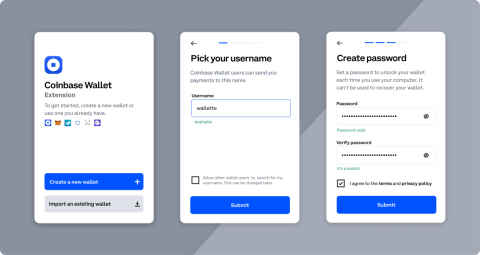To make a crypto wallet, download a wallet app like Coinbase Wallet and create your account. You can choose between self-custody wallets and hosted wallets, with options available for different needs and preferences in the crypto space.
Cryptocurrency wallets are essential tools for securely storing and managing digital assets, providing users with control over their funds. By setting up a crypto wallet, you gain the ability to send and receive various cryptocurrencies, track transactions, and ensure the safety of your investments.
Whether you opt for a hardware wallet for enhanced security or a software wallet for convenience, understanding how to create and use a crypto wallet is crucial in the world of digital finance. By following the necessary steps and selecting the right type of wallet, you can confidently navigate the decentralized landscape of cryptocurrency.

Understanding Crypto Wallets
When it comes to understanding crypto wallets, it’s important to know what is a cryptocurrency wallet and how do cryptocurrency wallets work. A cryptocurrency wallet is a digital tool that allows users to securely store and manage their digital assets. These wallets work by generating a public key and a private key, which are used to send and receive cryptocurrencies. The public key is like a bank account number, while the private key acts as a password. It’s crucial to choose the right blockchain for your crypto wallet, as different blockchains offer varying features and security levels. Understanding these fundamentals is essential in choosing the right blockchain for your crypto wallet.
Types Of Crypto Wallets
To make a crypto wallet, download a wallet app like Coinbase Wallet, create your account, and ensure you have full control and security over your funds. Consider factors like the wallet’s software, security features, and user experience when choosing the best option.
| Types of Crypto Wallets: |
|---|
| Hosted Wallets: Great for beginners, easy setup and management. |
| Non-Custodial Wallets: Users have full control over their funds. |
| Hardware Wallets: Physical devices for the highest security. |
| Paper Wallets: Printed documents storing private keys offline. |
Each type of crypto wallet has its own advantages and considerations. Hosted wallets are user-friendly and managed by a third party. Non-custodial wallets give users full autonomy and security. Hardware wallets provide offline storage for heightened protection. Paper wallets offer a secure way to store private keys offline. It’s important to choose a wallet type that aligns with your needs and level of comfort with managing digital assets.
Setting Up Your Own Wallet
Learn how to set up your own crypto wallet, starting with choosing between a hosted or non-custodial option. Once selected, download the wallet app, create your account, and manage your funds securely. Dive into the world of cryptocurrency with a personalized wallet that meets your needs.
| When setting up your own crypto wallet, follow these simple steps. First, download a reputable wallet app like Coinbase Wallet. Next, create your account without sharing any personal information. Finally, secure your wallet with a unique password and backup your wallet’s secret phrase securely.
Restoring a wallet with a secret phrase is crucial for regaining access to your funds in case of emergencies. Make sure to store your secret phrase in a safe and offline location. To restore your wallet, simply input the secret phrase in the wallet app and regain access to your assets seamlessly. |
Best Crypto Wallets
When it comes to setting up a crypto wallet, it’s essential to choose the best one for your needs. Coinbase Wallet is a popular choice for beginners, offering a user-friendly interface for managing various cryptocurrencies. MetaMask is well-suited for Ethereum and decentralized applications, while TrustWallet provides a convenient mobile option. If you prefer a desktop wallet, Electrum and Exodus are reliable choices, each offering its unique features and security measures. It’s crucial to research and compare different wallets to find the most suitable option for securing your crypto assets.
Building A Crypto Wallet App
Embark on creating your own Crypto Wallet app by setting up a secured wallet for managing digital assets. Explore key steps, such as choosing the right blockchain, understanding public versus private keys, and transferring crypto securely between wallets. Acquire insights on the significance of hot and cold wallets in safeguarding your investments.
| Building a Crypto Wallet App |
| Deciding on App Features |
| When it comes to building a crypto wallet app, one of the most important steps is deciding on the app features. You need to carefully consider what functionalities your app should have to meet the needs of your target users. This could include features such as account creation, wallet balance tracking, transaction history, buy/sell functionality, and integration with different blockchain networks. It’s important to prioritize the features based on user demand and market research. |
| Writing the App Code |
| Once you have finalized the app features, the next step is writing the app code. This involves coding the functionalities, implementing security measures, and ensuring seamless user experience. It’s crucial to follow best coding practices and use secure encryption methods to protect user data. Regular testing and debugging are essential to identify and fix any issues or vulnerabilities. Continuous improvement and updates are also necessary to stay up-to-date with the evolving crypto landscape. |
| Testing and Security Considerations |
| Before launching the crypto wallet app, thorough testing is necessary to ensure functionality and security. This includes testing the app on different devices, operating systems, and networks. It’s important to conduct both manual and automated testing to identify any bugs, usability issues, or vulnerabilities. User data protection should be a top priority, so implementing security measures such as two-factor authentication and encryption is crucial. Regular security audits and updates are essential to maintain the app’s security and protect user funds. |

Frequently Asked Questions Of How To Make Crypto Wallet
How Do I Create My Own Crypto Wallet?
To create your own crypto wallet, download a wallet app like Coinbase Wallet, create an account, and store your funds securely.
Which Crypto Wallet Is Best?
The best crypto wallet depends on your needs, but options like Coinbase Wallet, MetaMask, and TrustWallet are popular choices. Each offers unique features for beginners, mobile users, and desktop usage. Researching and comparing features can help you find the best fit for your crypto needs.
How Much Does It Cost To Build A Crypto Wallet?
Building a crypto wallet can vary in cost depending on several factors. However, the average cost ranges from $10,000 to $50,000.
Are Crypto Wallets Free?
Crypto wallets can be free to use for storing Bitcoin, as long as you’re not conducting transactions.
Conclusion
Creating a crypto wallet is an essential step in securing your digital assets. It’s crucial to choose a reliable and secure wallet that meets your specific needs. Whether it’s a hot or cold wallet, ensuring the safety of your cryptocurrency is paramount.
By following the steps outlined, you can confidently set up and manage your own crypto wallet, providing peace of mind and security for your digital investments.

